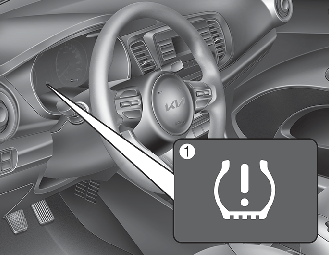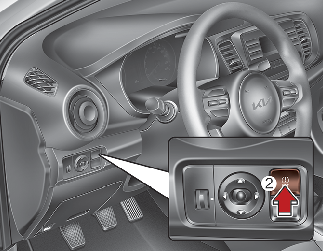Tire pressure monitoring system (TPMS, if equipped)


Low tire pressure telltale (1) / TPMS SET switch(2)
System Overview
The tire pressure monitoring system (TPMS) senses change in radius of the tire. If the tire pressure decreases below the recommended pressure, the system warning light will be illuminated.
For the system to function properly, it is the driver’s responsibility to set the system by following accurate procedure and set current tire pressure.
The warning light will illuminate on the cluster when one or more of your tires is under-inflated after the TPMS is set.
The warning light will also illuminate to warn the driver of system malfunction.
Please refer to the above image (1) for further information.
TPMS Setting
The driver can set the TPMS by following procedures below:
-
Inflate all tires to the recommend pressure.
-
Start the engine, make sure the vehicle is not moving, and press the TPMS switch (2) left side on the driver’s seat for over 3 seconds.
-
Check if the (
 ) warning indicator blinks for 4 seconds.
) warning indicator blinks for 4 seconds.
* If the warning light does not blink perform the process again from 2).
For recommended tire pressure of this vehicle, refer to More Details. or the tire pressure label on the driver’s door.
For proper function of the TPMS, the driver must set the system in following situations.
* Situation requiring TPMS setting
-
If the tire or wheel is repaired or replaced
-
If the tire or wheel is repositioned.
-
If the tire pressure is adjusted.
-
If the low pressure light is illuminated.
-
If suspension or ESC has been replaced.

If the system is set without adjusting tire pressure, false alarm could occur or the telltale will not be displayed even though the vehicle is significantly under-inflated.
Make sure all tires are properly adjusted to the recommended pressure when setting.
If the system is not set even in required situations, false alarm could occur or the telltale will not be displayed even though the vehicle is significantly under-inflated.
The system will not be set if you press the SET switch (2) while driving. Make sure to stop the vehicle and press the switch (2) for over 3 seconds.
-
Be sure the tire is cold before inflating the pressure.
A cold tire means the vehicle has been sitting for 3 hours or driven within 1.6km (1mile).
Indication of Low Tire Pressure
The ( ) warning light will illuminate when an under-inflated tire is indicated.
) warning light will illuminate when an under-inflated tire is indicated.
If the warning light illuminates, reduce your speed, avoid hard cornering and rapid braking. Have your vehicle inspected by a professional workshop. Kia recommends to visit an authorized Kia dealer/service partner.
Check the pressure of all tires and inflate to the proper pressure according to procedures, and if required, replace or repair the tires.
If you cannot reach a close service station, stop the vehicle at a safe place, check all tires and operate the TPMS setting procedure. If you are unable to adjust the tire pressure, use the repair tools to repair or change to spare tire and contact a professional workshop.
Kia recommends to call an authorized Kia dealer/service partner.
You may not be able to identify low tire pressure visually. Use precise tools to measure and adjust tire pressure.
Please note that a tire that is hot due to prolonged driving, therefore will have high pressure. We recommend you to measure and adjust the tire pressure after the vehicle has driven for less than 1.6km (1mile) within 3 hours.

-
The indicator may remain illuminated after changing to a spare tire, because radius of spare tire is different. Be sure to change to a regular tire.
-
For safe driving, please note that the TPMS is not a substitute for proper tire maintenance. It is the driver’s responsibility to maintain correct tire pressure, and all tires should be checked monthly to maintain the recommended pressure.
-
The warning light may illuminate if the system is not set in required situations.
-
In cold weather, the low tire pressure warning light may illuminate even if the tire was adjusted to the proper pressure. It does not mean your TPMS is malfunctioning because the decreased temperature leads to a lowering of tire pressure. Check the tires and adjust to the recommend pressure.
-
System performance may reduce in the following situations.
-
Improper system setting
-
Using tires on the market (Original tire recommended)
-
Driving on snowy, slippery, or unpaved roads
-
Hard cornering, rapid accelerating and braking repeatedly
-
Driving too slow or fast
-
If the vehicle is overloaded
-
If a spare tire or snow chain is installed
-
-
When filling tires with more air, conditions to turn off the low tire pressure telltale may not be met. This is because a tire inflator has a margin of error in performance. The low tire pressure telltale will be turned off if the tire pressure is above the recommended tire inflation pressure.

-
Driving with an under-inflated tire causes the tire to overheat and lead to tire failure. It also reduces tire tread life, handling of the vehicle, braking ability, and fuel efficiency, causing instability of the vehicle. In this case, contact professional workshop to maintain proper tire pressure. Kia recommends to contact an authorized Kia dealer/service partner.
-
Sudden damage to the tire caused by external factors may not be indicated immediately. If the vehicle is unstable, immediately remove your foot off the accelerator pedal, move the vehicle to a safe position for inspection.
Tire Pressure Monitoring System malfunction
The TPMS malfunction indicator will illuminate ( ) after it blinks for approximately 70 seconds when there is a problem with the Tire Pressure Monitoring System. This sequence
will continue upon subsequent vehicle start-ups as long as the malfunction exists.
) after it blinks for approximately 70 seconds when there is a problem with the Tire Pressure Monitoring System. This sequence
will continue upon subsequent vehicle start-ups as long as the malfunction exists.
If the indicator remains illuminated or illuminates even after TPMS setting, have the system checked by a professional workshop. Kia recommends to visit an authorized Kia dealer/service partner.

-
If there is a malfunction with the TPMS, low tire pressure will not be indicated. In this case, have the system serviced by a professional workshop. Kia recommends to visit an authorized Kia dealer/service partner.
-
If the system does not work due to TPMS removal or installation of related parts with different specification, it might be a problem when the vehicle is being regularly inspected.
-
When repairing TPMS related parts, be sure to replace them to parts with original specification or those which satisfy the TPMS regulation.
-
TPMS related parts : tire, wheel, ESC unit, suspension
-
Reference : Indicator Light Status
|
Status |
Symbol |
|---|---|
|
Low Pressure |
 Illuminates |
|
System Malfunction |
Illuminates after blinking (70 seconds) |
|
Setting |
Turns off after blinking (4seconds) |
 ►
►